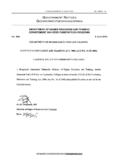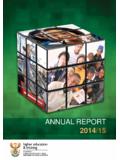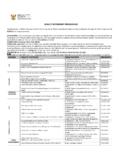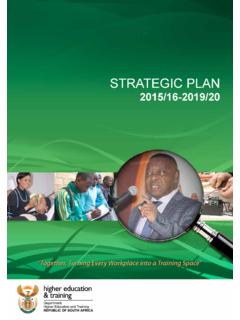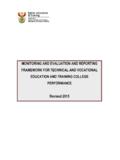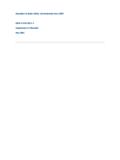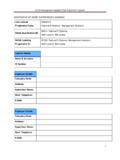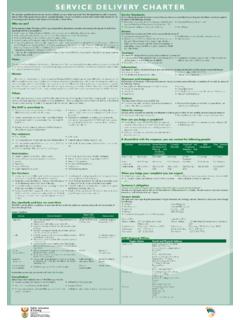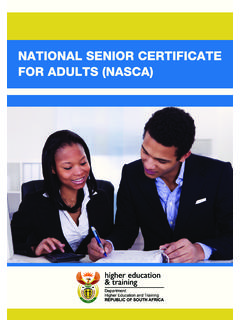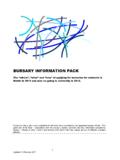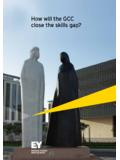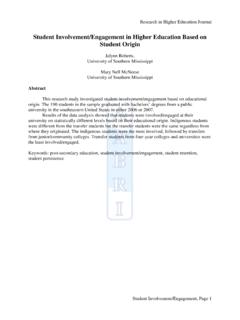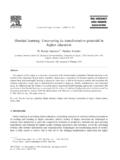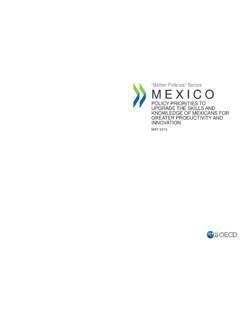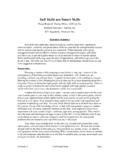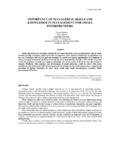Transcription of LANGUAGE POLICY FOR HIGHER EDUCATION
1 LANGUAGE POLICY FOR HIGHER EDUCATION MINISTRY OF EDUCATION NOVEMBER 2002 LANGUAGE POLICY FOR HIGHER EDUCATION INTRODUCTION .. the building blocks of this nation are all our languages working together, our unique idiomatic expressions that reveal the inner meanings of our experiences. These are the foundations on which our common dream of nationhood should be nurturing of this reality depends on our willingness to learn the languages of others, so that we in practice accord all our languages the same respect. In sharing one s LANGUAGE with another, one does not lose possession of one s words, but agrees to share these words so as to enrich the lives of others. For it is when the borderline between one LANGUAGE and another is erased, when the social barriers between the speaker of one LANGUAGE and another are broken, that a bridge is built, connecting what were previously two separate sites into one big space for human interaction, and, out of this, a new world emerges and a new nation is born.
2 President Thabo Mbeki 27 August 1999 1. South Africa is a country of many languages and tongues. However, our languages have not always been working together . In the past, the richness of our linguistic diversity was used as an instrument of control, oppression and exploitation. The existence of different languages was recognised and perversely celebrated to legitimise the POLICY of separate development that formed the cornerstone of apartheid. However, in practice, all our languages were not accorded equal status. The POLICY of separate development resulted in the privileging of English and Afrikaans as the official languages of the apartheid state and the marginalisation and under-development of African and other languages. 2. The use of LANGUAGE POLICY as an instrument of control, oppression and exploitation was one of the factors that triggered the two great political struggles that defined South Africa in the twentieth century the struggle of the Afrikaners against British imperialism and the struggle of the black community against white rule.
3 Indeed, it was the attempt by the apartheid 2state to impose Afrikaans as a medium of instruction in black schools that gave rise to the mass struggles of the late 1970s and 1980s. 3. The role of all our languages working together to build a common sense of nationhood is consistent with the values of democracy, social justice and fundamental rights , which are enshrined in the Constitution. The Constitution, in line with its founding provisions of non-racialism, non-sexism, human dignity and equity, not only accords equal status to all our languages, but recognises that given the marginalisation of indigenous languages in the past, the state must take practical and positive measures to elevate the status and advance the use of these languages (Section 6 (2) of the Constitution). The Constitution, furthermore, in the Bill of Rights, grants that: Everyone has the right to use the LANGUAGE and to participate in the cultural life of their choice, but no one exercising these rights may do so in a manner inconsistent with any provision of the Bill of Rights (Section 30 of the Constitution).
4 Everyone has the right to receive EDUCATION in the official LANGUAGE or languages of their choice in public educational institutions where that EDUCATION is reasonably practicable. In order to ensure the effective access to, and implementation of, this right, the state must consider all reasonable educational alternatives, including single medium institutions, taking into account- (a) equity; (b) practicability; and (c) the need to redress the results of past racially discriminatory laws and practices (Section 29 (2) of the Constitution). The Constitution delineates clearly the limit to the right of individuals to receive EDUCATION in the LANGUAGE of their choice. The exercise of this right 3cannot negate considerations of equity and redress in the context of the values that underpin our shared aspirations as a nation. In this regard, as the late Chief Justice Ismail Mahomed, stated in 1995: All Constitutions seek to articulate, with differing degrees of intensity and detail, the shared aspirations of a nation; the values which bind its people and which discipline its government and its national institutions; the basic premises upon which judicial, legislative and executive power is to be wielded; the constitutional limits and the conditions upon which that power is to be exercised; the national ethos which defines and regulates that exercise; and the moral and ethical direction which the nation has identified for its future.
5 Chief Justice I Mahomed in S v Makwanyane and another 1995 The values and shared aspirations of a democratic South Africa, which are enshrined in the Constitution of 1996, require the Constitution, as Justice Kate O Regan suggests, to compel transformation. She argues that the attainment of the vision of the Constitution is dependent on urgently addressing the deep patterns of inequality which scar our society and which are the legacy of apartheid and colonialism . The Constitution, is therefore, according to Justice O Regan: ..a call to action to all South Africans, to seek to build a just and free democratic society in which the potential of each person is freed . Justice O Regan in Equality: Constitutional Imperatives, 2002 4. The role of LANGUAGE and access to LANGUAGE skills is critical to ensure the right of individuals to realise their full potential to participate in and contribute to the social, cultural, intellectual, economic and political life of South African society.
6 5. LANGUAGE has been and continues to be a barrier to access and success in HIGHER EDUCATION ; both in the sense that African and other languages have not been developed as academic/scientific languages and in so far 4as the majority of students entering HIGHER EDUCATION are not fully proficient in English and Afrikaans. 6. The challenge facing HIGHER EDUCATION is to ensure the simultaneous development of a multilingual environment in which all our languages are developed as academic/scientific languages, while at the same time ensuring that the existing languages of instruction do not serve as a barrier to access and success. The POLICY framework outlined below attempts to address this challenge. BACKGROUND 7. The Minister of EDUCATION must, in accordance with Section 27(2) of the HIGHER EDUCATION Act of 1997, determine LANGUAGE POLICY for HIGHER EDUCATION . Subject to the POLICY determined by the Minister, the councils of public HIGHER EDUCATION institutions, with the concurrence of their senates, must determine the LANGUAGE POLICY of a HIGHER EDUCATION institution and must publish and make such POLICY available on request.
7 The requirement of the Act takes into account the authority of institutions to determine LANGUAGE POLICY provided that such determination is within the context of public accountability and the Ministry s responsibility to establish the POLICY parameters. 8. The Ministry s framework for LANGUAGE POLICY in HIGHER EDUCATION is outlined in this statement. 9. In developing such a framework, and in accordance with the HIGHER EDUCATION Act, the Minister of EDUCATION requested advice from the Council on HIGHER EDUCATION on the development of an appropriate LANGUAGE POLICY for HIGHER EDUCATION . This followed the decision of Cabinet in 1999 to prioritise the development of a LANGUAGE framework for HIGHER EDUCATION . In July 2001, the Council submitted its advice to the Minister in a report entitled LANGUAGE POLICY Framework for South African HIGHER EDUCATION . The Report is attached as Annexure 1.
8 A range of 5proposals and recommendations has been advanced in this report, many of which have informed the development of this POLICY document. However, a few of the recommendations will require further consideration. The Ministry will engage with the Council in this regard. 10. Subsequent to the advice received from the Council, the Minister invited Professor G J Gerwel to convene an informal committee to provide him with advice specifically with regard to Afrikaans. In particular, the committee was requested to advise on ways in which Afrikaans can be assured of continued long term maintenance, growth and development as a LANGUAGE of science and scholarship in the HIGHER EDUCATION system without non-Afrikaans speakers being unfairly denied access within the system, or the use and development of the LANGUAGE as a medium of instruction wittingly or unwittingly becoming the basis for racial, ethnic or cultural division and discrimination.
9 The reason for this focus on Afrikaans is that other than English, Afrikaans is the only other South African LANGUAGE which is employed as a medium of instruction and official communication in institutions of HIGHER EDUCATION . In January 2002, the Gerwel Committee submitted its advice to the Minister, which is contained in its report entitled Report to Minister of EDUCATION A K Asmal by the Informal Committee Convened to Advise on the Position of Afrikaans in the University System . This Report is attached as Annexure 2. In addition, the Ministry considered the views expressed by a number of different constituencies, including those of the Vice-Chancellors of the Historically Afrikaans Institutions. 11. By way of background information, it is important to note that the South African student population in HIGHER EDUCATION is linguistically diverse and it is not uncommon to find a variety of home languages represented in the student body of a single institution.
10 Table 1 below provides a breakdown of the home languages of students registered in public universities and technikons in 2000. As indicated, although English and Afrikaans are the two most frequently reported home languages, the extent of linguistic 6diversity is evident in the fact that 50% of total student enrolments report an indigenous African LANGUAGE or another LANGUAGE as the home LANGUAGE . The extent of linguistic diversity within individual institutions depends on the degree to which students are recruited locally, regionally or nationally. Table 1 HOME LANGUAGE UNIVERSITIES TECHNIKONS TOTAL % OF TOTAL ENROLMENTS Afrikaans 71,97927,36399,342 16 English 136,95755,509192,466 32 IsiNdebele 2,6416373,278 1 IsiXhosa 38,24728,39666,643 11 IsiZulu 39,36328,50967.
